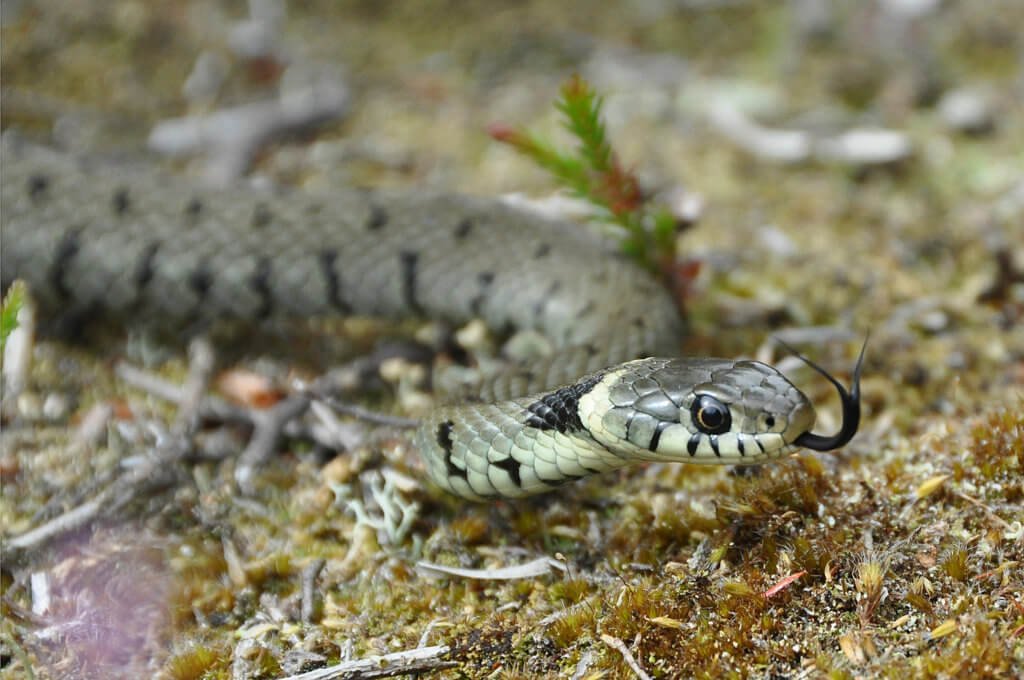
Tim writes: I’m sure that many of you will have seen the surprising news announced recently that Britain has a new species of snake; Barred Grass Snake (Natrix helvetica). Without exception, every media source announced that this was an additional species for Britain, bringing the total to four (Barred Grass Snake, Grass Snake, Smooth Snake, Adder). For example this piece on the BBC which opens with the line “A new type of snake has been identified in the UK, bringing the total number of species to four.”
But this is wrong. The Barred Grass Snake (Natrix helvetica) is our only Grass Snake in Britain, and it has been taxonomically split from the Eastern Grass Snake (Natrix natrix) which was previously thought to inhabit Britain. The Eastern Grass Snake retained the scientific name (Natrix natrix) because Linnaeus first named it from Sweden, where the Eastern species occurs. Barred Grass Snake (N. helvetica) occurs from the Rhine westwards to the Pyrenees including Britain. Eastern Grass Snake (N. natrix) occurs west of the Rhine and in Scandinavia. Interestingly a small number of Grass Snakes from southern and southeastern Europe have been found in Britain but these were discounted as certain escapes from the pet trade. These were of the subspecies Natrix natrix persa which has not quite separated as a full species from the Eastern Grass Snake. Eastern Grass Snake (Natrix natrix) has not been recorded in Britain, not even as an escaped pet.
The scientific paper on which this is based is here.
I photographed this Barred Grass Snake in Dorset some years back when I assumed it was a plain old Grass Snake. The scientific name helvetica was the name we used to use for our British subspecies of Grass Snake, which also occurs in parts of Europe. Its distinguishing features were a barred body and a less prominent yellow collar (compared with Eastern European/Scandinavian Grass Snakes). The name helvetica is the Latin name for Switzerland, where Barred Grass Snake also occurs.
[registration_form]
That’s the most succinct explanation I’ve seen so far! This seems to have been an object lesson in how to confuse the media ☹️
Not “how to confuse the media” but how the media confuses its readers.
The original paper was clear enough it’s just that most of the mainstream, popular media displays a frightening lack of scientific understanding.
succinct explanation of what or Who our native Grass Snake is and lovely photo Tim. Also means an “armchair tick” as I’ve seen “Grass Snak”e in Bulgaria as well as the UK
Great article Tim. The media coverage of this was really misleading and those who weren’t up on snake taxonomy would have been well confused. Good of you (and Mark) to put this in the public domain. Do the media get the reporting of things like Korea so wrong? (!!)
A huge thanks to Tim Melling for highlighting this. After reading Tim’s description on Flickr and the link to the paper, I confirmed it myself. It is a complete mystery as how the media concluded that now we had 4 species of native snake. The Guardian printed the Press Association feature on this in full, unedited, and it is clear this is the origin of this profound mistake the media have reported as verbatim fact. It’s obviously whoever, read the paper and wrote the Press Association article circulated to the media is not scientifically literate. For a start the Press Association article referred to four “kinds” of snake, not species.
It really is shocking just how bad the media is when it comes to matters of biodiversity, the natural world and accuracy. I have made dozens of complaints. Some are corrected and some are not.
I have written twice to the Guardian Readers editor about this, and my emails have simply been stonewalled.
Another example of why we should not take the media’s word for anything without checking back to source, a fundamental requirement for scientists, or at least it was in days gone by;)
Thanks Tim & Mark, let’s spread the word that conservationists bailed out the media?
A useful correction but I also suspect that even Tim is jumping the gun.
Species do not get renamed (or split) on the basis of one scientific paper. This would need to be officially confirmed by whichever taxonomic authority applies to snakes.
Yes, that’s a very important point, and it’s one I made in my representations to the Guardian about the inaccurate Press Association article about this they published, where I said “And even if it is accepted that the name be changed to Natrix helvetica, there would still be only one species of Grass Snake present in Britain.”
Although to be fair to Tim’s point, it was based on the assumption that the species/subspecies status would be changed, which was the assumptions of the articles, not necessarily of Tim himself.
There does appear to be one Natrix natrix dot in Sussex, which suggests an escape? – https://www.nature.com/articles/s41598-017-07847-9/figures/1
I am not an expert, but the small snake I saw in a garden today was not a Slow Worm or an Adder. Scaled in dark green and with light brown bars, the articles above would say it is Natrix Helvetica.
Location of this sighting was a garden in the village of TREFRIW in Conwy.